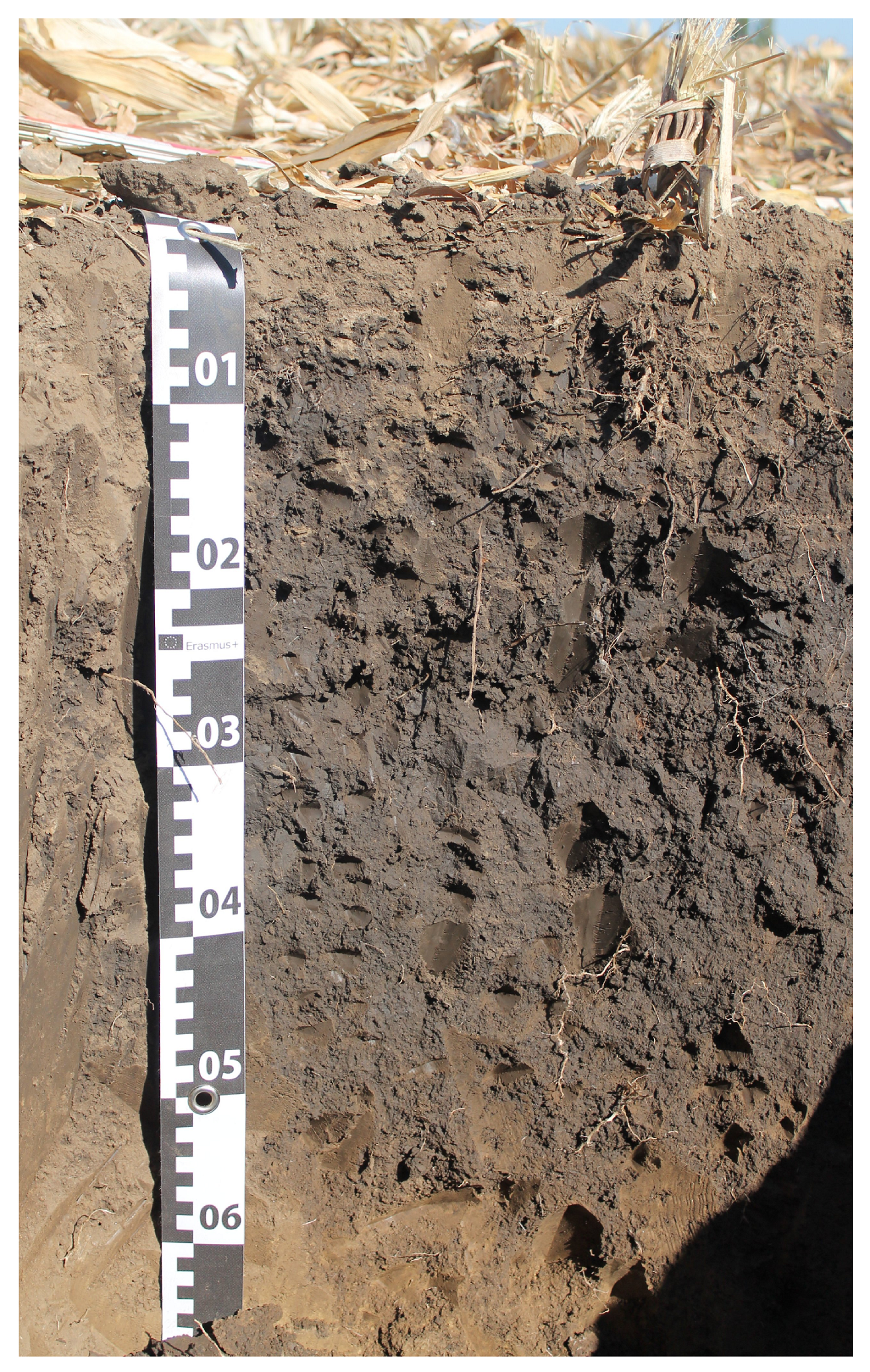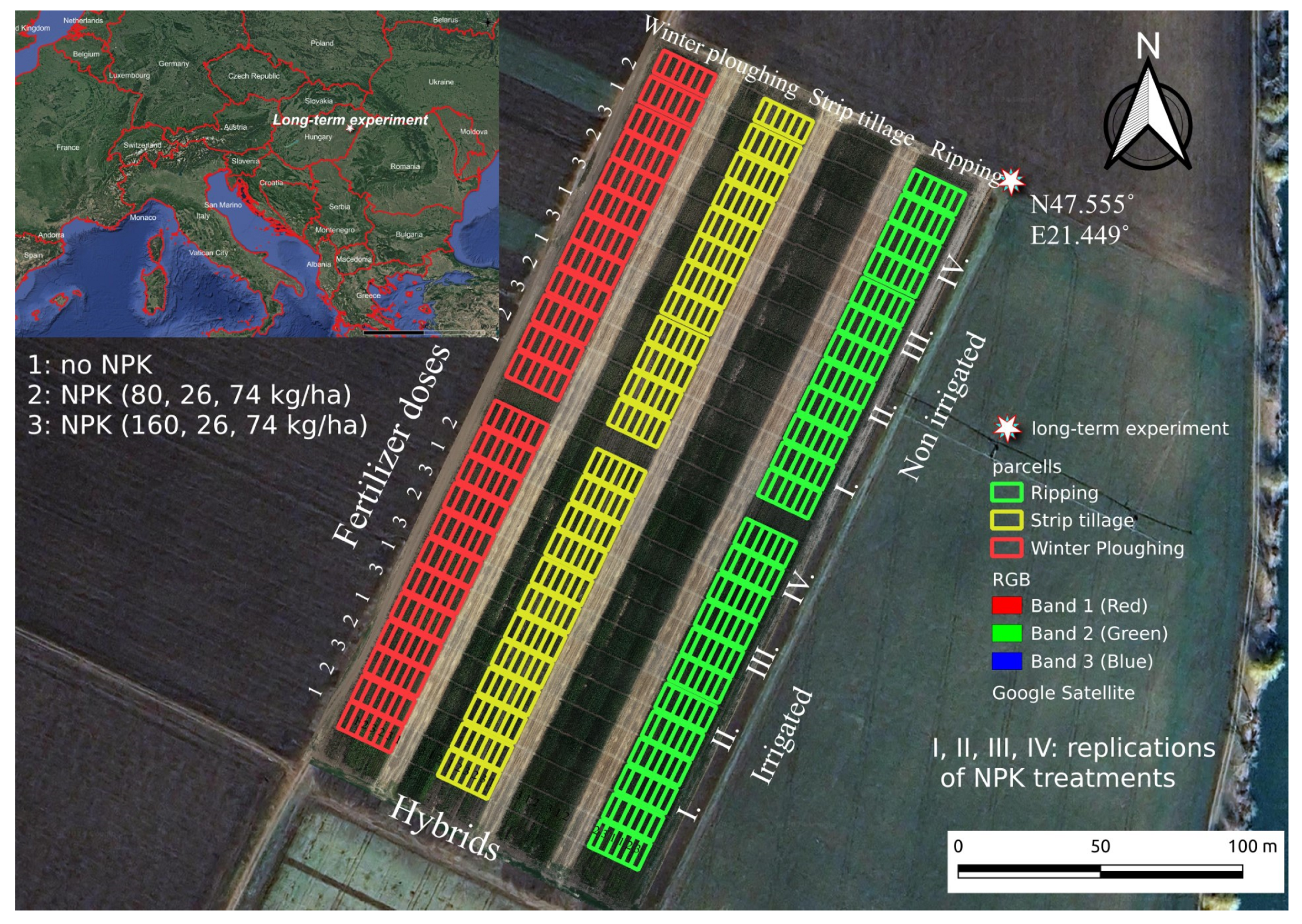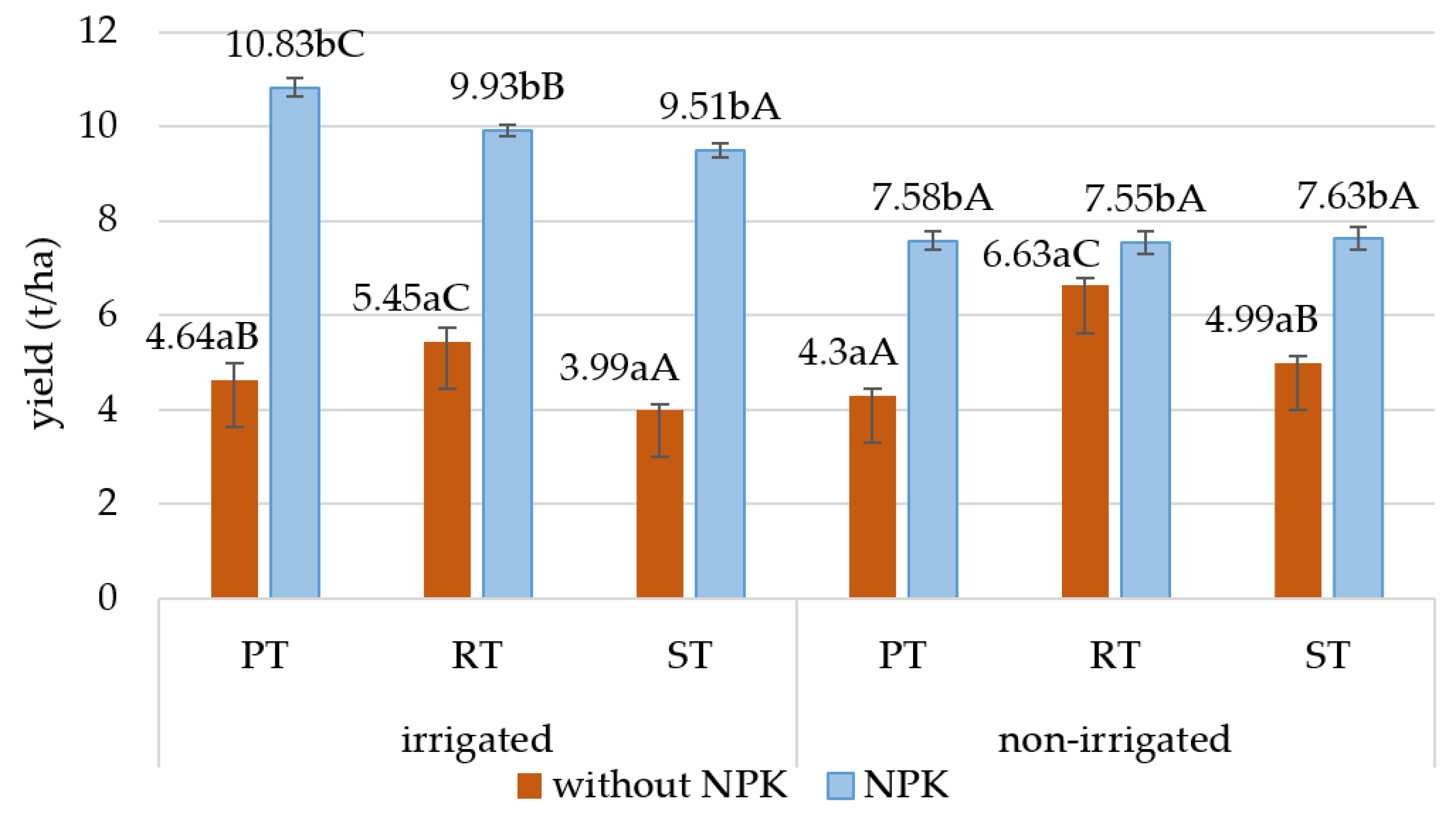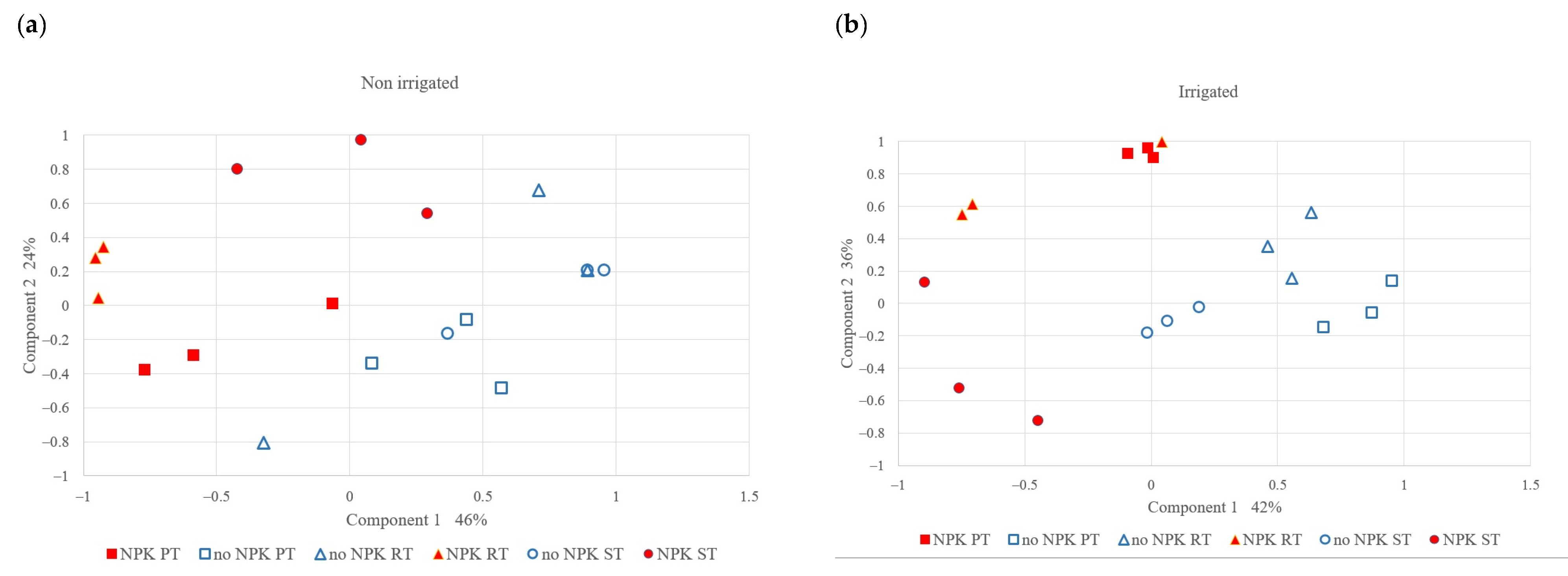Changes in Microbial Community and Activity of Chernozem Soil under Different Management Systems in a Long-Term Field Experiment in Hungary
Abstract
1. Introduction
2. Materials and Methods
2.1. Experimental Design
2.2. Yield of Maize
2.3. Soil Sampling
2.4. Analysis of Soil Chemical Parameters
2.5. Analysis of Soil Microbial Parameters
2.6. PLFA Analysis
2.7. Statistical Analysis
3. Results
3.1. Yield of Maize
3.2. The Physicochemical Parameters and Enzyme Activities of Soil
3.3. Soil Microbial Biomass and Community Composition
3.4. The Results of PCA
4. Discussion
4.1. Effects of Tillage Methods
4.2. Effects of NPK Fertilization
5. Conclusions
Author Contributions
Funding
Institutional Review Board Statement
Informed Consent Statement
Data Availability Statement
Conflicts of Interest
References
- Ibáñez, J.; Pérez-Gómez, R.; Martínez, F.S.J. The spatial distribution of soils across Europe: A fractal approach. Ecol. Complex. 2009, 6, 294–301. [Google Scholar] [CrossRef]
- Koós, S.; Pirkó, B.; Szatmári, G.; Csathó, P.; Magyar, M.; Szabó, J.; Fodor, N.; Pásztor, L.; Laborczi, A.; Pokovai, K. Influence of the Shortening of the Winter Fertilization Prohibition Period in Hungary Assessed by Spatial Crop Simulation Analysis. Sustainability 2021, 13, 417. [Google Scholar] [CrossRef]
- Szabó, A. Effects of compost treatments on the dry matter-, ash-, total acidity-, sugar- and Vitamin C content of the integrated and organic produced Golden Delicious and Pinova apples. J. MacroTrends Appl. Sci. 2014, 2, 24–42. [Google Scholar]
- Pirkó, B.; Koós, S.; Szabó, J.; Radimszky, L.; Csathó, P.; Árendás, T.; Fodor, N.; Szabó, A. Results of Hungarian field test trials set up for establishing new maximum permitted N dose values. Stud. Agric. Econ. 2020, 122, 77–85. [Google Scholar] [CrossRef]
- Rasmussen, K. Impact of ploughless soil tillage on yield and soil quality: A Scandinavian review. Soil Tillage Res. 1999, 53, 3–14. [Google Scholar] [CrossRef]
- Licht, M.A.; Al-Kaisi, M. Strip-tillage effect on seedbed soil temperature and other soil physical properties. Soil Tillage Res. 2005, 80, 233–249. [Google Scholar] [CrossRef]
- Mupangwa, W.; Twomlow, S.; Walker, S.; Hove, L. Effect of minimum tillage and mulching on maize (Zea mays L.) yield and water content of clayey and sandy soils. Phys. Chem. Earth Parts A/B/C 2007, 32, 1127–1134. [Google Scholar] [CrossRef]
- Luan, H.; Yuan, S.; Gao, W.; Tang, J.; Li, R.; Zhang, H.; Huang, S. Aggregate-related changes in living microbial biomass and microbial necromass associated with different fertilization patterns of greenhouse vegetable soils. Eur. J. Soil Biol. 2021, 103, 103291. [Google Scholar] [CrossRef]
- Csontos, P.; Mucsi, M.; Ragályi, P.; Tamás, J.; Kalapos, T.; Pápay, G.; Mjazovszky, Á.; Penksza, K.; Szili-Kovács, T. Standing Vegetation Exceeds Soil Microbial Communities in Soil Type Indication: A Procrustes Test of Four Salt-Affected Pastures. Agronomy 2021, 11, 1652. [Google Scholar] [CrossRef]
- Bowles, T.M.; Acosta-Martínez, V.; Calderón, F.; Jackson, L.E. Soil enzyme activities, microbial communities, and carbon and nitrogen availability in organic agroecosystems across an intensively-managed agricultural landscape. Soil Biol. Biochem. 2014, 68, 252–262. [Google Scholar] [CrossRef]
- Kovács, A.B.; Kremper, R.; Kincses, I.; Leviczky, Á. Influences of different organic fertilizers on nutrients of humic sandy soil and on the growth of Spinach (Spinacia oleracea L.). Acta Agrar. Debreceniensis 2016, 70, 23–28. [Google Scholar] [CrossRef]
- Cookson, W.R.; Murphy, D.V.; Roper, M.M. Characterizing the relationships between soil organic matter components and microbial function and composition along a tillage disturbance gradient. Soil Biol. Biochem. 2008, 40, 763–777. [Google Scholar] [CrossRef]
- Dai, H.; Zhang, H.; Li, Z.; Liu, K.; Zamanian, K. Tillage Practice Impacts on the Carbon Sequestration Potential of Topsoil Microbial Communities in an Agricultural Field. Agronomy 2021, 11, 60. [Google Scholar] [CrossRef]
- Demeter, I.; Makadi, M.; Tomocsik, A.; Aranyos, T.; Micheli, E.; Posta, K. Chemical and microbiological properties of Hungarian sandy soils under different management practices. Appl. Ecol. Environ. Res. 2018, 16, 3473–3488. [Google Scholar] [CrossRef]
- Young, I.; Ritz, K. Tillage, habitat space and function of soil microbes. Soil Tillage Res. 2000, 53, 201–213. [Google Scholar] [CrossRef]
- Helgason, B.L.; Walley, F.L.; Germida, J.J. Fungal and bacterial abundance in long-term no-till and intensive-till soils of the northern great plains. Soil Sci. Soc. Am. J. 2009, 73, 120–127. [Google Scholar] [CrossRef]
- Säle, V.; Aguilera, P.; Laczko, E.; Mäder, P.; Berner, A.; Zihlmann, U.; van der Heijden, M.G.; Oehl, F. Impact of conservation tillage and organic farming on the diversity of arbuscular mycorrhizal fungi. Soil Biol. Biochem. 2015, 84, 38–52. [Google Scholar] [CrossRef]
- Kádár, I.; Ragályi, P. Mineral fertilization and grass productivity in a long-term field experiment. Arch. Agron. Soil Sci. 2012, 58 (Suppl. S1), S127–S131. [Google Scholar] [CrossRef]
- WRB, I.-W. World reference base for soil resources. World Soil Resour. Rep. 2006, 103, 1–128. [Google Scholar]
- Tamás, A.; Kovács, E.; Horváth, É.; Juhász, C.; Radócz, L.; Rátonyi, T.; Ragán, P. Assessment of NDVI Dynamics of Maize (Zea mays L.) and Its Relation to Grain Yield in a Polyfactorial Experiment Based on Remote Sensing. Agriculture 2023, 13, 689. [Google Scholar] [CrossRef]
- Öhlinger, R. Soil respiration by titration. In Methods in Soil Biology; Springer: Berlin/Heidelberg, Germany, 1995; pp. 95–98. [Google Scholar]
- Von Mersi, W.; Schinner, F. Dehydrogenase activity with the substrate INT. In Methods in Soil Biology; Springer: Berlin/Heidelberg, Germany, 1996; pp. 243–245. [Google Scholar]
- Frankeberger, W.; Johanson, J. Method of measuring invertase activity in soils. Plant Soil 1983, 74, 301–311. [Google Scholar] [CrossRef]
- Kandeler, E.; Gerber, H. Short-term assay of soil urease activity using colorimetric determination of ammonium. Biol. Fertil. Soils 1988, 6, 68–72. [Google Scholar] [CrossRef]
- Tabatabai, M. Soil enzymes. In Methods of Soil Analysis: Part 2 Microbiological and Biochemical Properties; John and Wiley and Son: Hoboken, NJ, USA, 1994; Volume 5, pp. 775–833. [Google Scholar] [CrossRef]
- Ellis, S.; Ritz, K. A modified high-throughput analysis of PLFAs in soil. MethodsX 2018, 5, 1491–1497. [Google Scholar] [CrossRef] [PubMed]
- Frostegård, Å.; Tunlid, A.; Bååth, E. Phospholipid fatty acid composition, biomass, and activity of microbial communities from two soil types experimentally exposed to different heavy metals. Appl. Environ. Microbiol. 1993, 59, 3605–3617. [Google Scholar] [CrossRef] [PubMed]
- Gude, A.; Kandeler, E.; Gleixner, G. Input related microbial carbon dynamic of soil organic matter in particle size fractions. Soil Biol. Biochem. 2012, 47, 209–219. [Google Scholar] [CrossRef]
- Zelles, L. Fatty acid patterns of phospholipids and lipopolysaccharides in the characterisation of microbial communities in soil: A review. Biol. Fertil. Soils 1999, 29, 111–129. [Google Scholar] [CrossRef]
- Bach, E.M.; Baer, S.G.; Meyer, C.K.; Six, J. Soil texture affects soil microbial and structural recovery during grassland restoration. Soil Biol. Biochem. 2010, 42, 2182–2191. [Google Scholar] [CrossRef]
- Reichardt, W.; Mascarina, G.; Padre, B.; Doll, J. Microbial communities of continuously cropped, irrigated rice fields. Appl. Environ. Microbiol. 1997, 63, 233–238. [Google Scholar] [CrossRef]
- Balser, T.C.; Gutknecht, J.L.; Liang, C. How will climate change impact soil microbial communities? In Soil Microbiology and Sustainable Crop Production; Springer: Berlin/Heidelberg, Germany, 2010; pp. 373–397. [Google Scholar] [CrossRef]
- Klikocka, H.; Narolski, B.; Klikocka, O.; Glowacka, A.; Juszczak, D.; Onuch, J.; Gaj, R.; Michałkiewicz, G.; Cybulska, M.; Stepaniuk, S. The effect of soil tillage and nitrogen fertilization on microbiological parameters of soil on which spring Triticale is grown. Pol. J. Environ. Stud. 2012, 21, 1675–1685. [Google Scholar]
- Oehl, F.; Sieverding, E.; Mäder, P.; Dubois, D.; Ineichen, K.; Boller, T.; Wiemken, A. Impact of long-term conventional and organic farming on the diversity of arbuscular mycorrhizal fungi. Oecologia 2004, 138, 574–583. [Google Scholar] [CrossRef] [PubMed]
- Jaskulska, I.; Jaskulski, D. Change in soil properties after 5 years of using strip-till technology. Mech. Agric. Conserv. Resour. 2019, 65, 193–195. [Google Scholar]
- Iqbal, J.; Hu, R.; Feng, M.; Lin, S.; Malghani, S.; Ali, I.M. Microbial biomass, and dissolved organic carbon and nitrogen strongly affect soil respiration in different land uses: A case study at Three Gorges Reservoir Area, South China. Agric. Ecosyst. Environ. 2010, 137, 294–307. [Google Scholar] [CrossRef]
- Romaneckas, K.; Avizienyte, D.; Boguzas, V.; Sarauskis, E.; Jasinskas, A.; Marks, M. Impact of tillage systems on chemical, biochemical and biological composition of soil. J. Elem. 2016, 21, 513–526. [Google Scholar]
- Ghimire, R.; Thapa, V.R.; Acosta-Martinez, V.; Schipanski, M.; Slaughter, L.C.; Fonte, S.J.; Shukla, M.K.; Bista, P.; Angadi, S.V.; Mikha, M.M. Soil Health Assessment and Management Framework for Water-Limited Environments: Examples from the Great Plains of the USA. Soil Syst. 2023, 7, 22. [Google Scholar] [CrossRef]
- Calderon, F.J.; Jackson, L.E.; Scow, K.M.; Rolston, D.E. Short-term dynamics of nitrogen, microbial activity, and phospholipid fatty acids after tillage. Soil Sci. Soc. Am. J. 2001, 65, 118–126. [Google Scholar] [CrossRef]
- Bardgett, R.D.; Jones, A.C.; Jones, D.L.; Kemmitt, S.J.; Cook, R.; Hobbs, P.J. Soil microbial community patterns related to the history and intensity of grazing in sub-montane ecosystems. Soil Biol. Biochem. 2001, 33, 1653–1664. [Google Scholar] [CrossRef]
- Rao, M.; Scelza, R.; Gianfreda, L. Soil enzymes. In Enzymes in Agricultural Sciences; OMICS Group eBooks: Foster City, CA, USA, 2014; pp. 10–43. [Google Scholar]
- Bååth, E. The use of neutral lipid fatty acids to indicate the physiological conditions of soil fungi. Microb. Ecol. 2003, 45, 373–383. [Google Scholar] [CrossRef]
- Aziz, M.A.; Hazra, F.; Salma, S.; Nursyamsi, D. Soil enzyme activities and their relationship to total soil bacteria, soil microbial biomass and soil chemical characteristics of organic and conventional farming. J. Trop. Soils 2019, 23, 133–141. [Google Scholar]
- Rousk, J.; Brookes, P.C.; Bååth, E. The microbial PLFA composition as affected by pH in an arable soil. Soil Biol. Biochem. 2010, 42, 516–520. [Google Scholar] [CrossRef]





| Soil Physicochemical Parameters | Soil Microbiological Parameters | ||||||||
|---|---|---|---|---|---|---|---|---|---|
| Moisture Content % | pHKCl | SOC % | TN % | CO2 Emission (mg/kg/10 Days) | DHA (µg INTF/g/2 h) | PA (P2O5 mg/100 g/2 h) | SA (Glucose mg/100 g/ 24 h) | UA (NH4-N mg/100 g/ 2 h) | |
| Tillage | 0.082 | 0.881 | 0.000 *** | 0.000 *** | 0.01 ** | 0.000 *** | 0.000 *** | 0.000 *** | 0.135 |
| NPK | 0.001 *** | 0.000 *** | 0.026 * | 0.001 *** | 0.009 ** | 0.000 *** | 0.000 *** | 0.659 n.s | 0.000 *** |
| Irrigation | 0.001 *** | 0.017 * | 0.769 n.s. | 0.392 n.s. | 0.392 n.s. | 0.018 n.s | 0.285 n.s | 0.254 n.s | 0.175 n.s |
| Irr. × NPK | 0.962 n.s | 0.065 n.s | 0.206 n.s. | 0.578 n.s | 0.849 n.s | 0.210 n.s | 0.173 n.s | 0.272 n.s. | 0.304 n.s |
| Irr. × till. | 0.964 n.s | 0.346 n.s | 0.371 n.s | 0.877 n.s | 0.061 n.s. | 0.094 n.s | 0.613 n.s | 0.835 n.s | 0.607 n.s |
| NPK × till. | 0.740 n.s | 0.695 n.s | 0.093 n.s | 0.168 n.s | 0.365 n.s | 0.102 n.s | 0.041 n.s | 0.161 n.s | 0.222 n.s |
| Irr × NPK × Till | 0.680 n.s | 0.873 n.s | 0.191 n.s | 0.051 n.s | 0.202 n.s | 0.523 n.s | 0.611 n.s | 0.778 n.s | 0.861 n.s |
| Soil Physicochemical Parameters | Soil Microbiological Parameters | ||||||||
|---|---|---|---|---|---|---|---|---|---|
| Moisture Content % | pHKCl | SOC % | TN % | CO2 Emission (mg/kg/ 10 Days) | DHA (µg INTF/ g/2 h) | PA (P2O5 mg/ 100 g/2 h) | SA (Glucose mg/100 g/ 24 h) | UA (NH4-N mg/100 g/ 2 h) | |
| Tillage | |||||||||
| PT | 12.6 ± 0.7 a | 4.64 ± 0.15 a | 1.67 ± 0.03 a | 0.13 ± 0.00 a | 137.4 ± 0.2 a | 75.47 ± 3.68 a | 29.81 ± 5.41 a | 10.48 ± 0.72 a | 58.90 ± 10.59 a |
| RT | 11.3 ± 0.8 a | 4.77 ± 0.19 a | 2.09 ± 0.07 b | 0.17 ± 0.01 b | 145.4 ± 0.2 b | 87.73 ± 5.58 b | 47.19 ± 6.98 b | 15.85 ± 1.67 b | 68.9 ± 10.44 a |
| ST | 11.7 ± 0.8 a | 4.69 ± 0.18 a | 2.15 ± 0.06 b | 0.17 ± 0.01 b | 139.5 ± 0.2 b | 89.83 ± 4.60 b | 51.70 ± 8.72 b | 14.83 ± 0.99 b | 58.6 ± 13.85 a |
| Fertilizer | |||||||||
| Control | 12.7 ± 0.3 b | 5.2 ± 0.09 b | 1.87 ± 0.03a | 0.14 ± 0.05 a | 138.0 ± 0.2 a | 88.99 ± 3.92 b | 34.21 ± 3.38 a | 13.88 ± 1.38 a | 47.62 ± 5.40 a |
| NPK | 11.0 ± 0.27 a | 4.2 ± 0.06 a | 2.07 ± 0.07 a | 0.17 ± 0.07 b | 143.6 ± 0.2 b | 79.69 ± 4.66 a | 51.59 ± 7.82 b | 13.53 ± 1.57 a | 76.69 ± 7.78 b |
| Independent Variables | Total PLFAs | Fungi | AM Fungi | Total Bacteria | GN | GP | F/B | GP/GN |
|---|---|---|---|---|---|---|---|---|
| Tillage | 0.000 *** | 0.000 *** | 0.206 n.s | 0.000 *** | 0.000 *** | 0.001 *** | 0.000 *** | 0.339 n.s |
| NPK fertilization | 0.001 *** | 0.390 n.s | 0.000 *** | 0.297 n.s | 0.000 *** | 0.389 n.s | 0.503 n.s | 0.001 *** |
| Irrigation | 0.234 n.s | 0.466 n.s | 0.000 *** | 0.296 n.s | 0.000 *** | 0.443 n.s | 0.740 n.s | 0.104 n.s |
| NPK × tillage | 0.027 * | 0.014 * | 0.027 * | 0.057 n.s | 0.002 *** | 0.229 n.s | 0.037 n.s | 0.314 n.s |
| Irrigation × NPK | 0.360 n.s | 0.020 * | 0.018 ** | 0.004 n.s | 0.242 n.s | 0.834 n.s | 0.004 ** | 0.914 n.s |
| Irrigation × tillage | 0.227 n.s | 0.002 ** | 0.001 *** | 0.000 *** | 0.016 * | 0.576 n.s | 0.000 *** | 0.032 * |
| Irrigation × NPK × tillage | 0.444 n.s | 0.060 n.s | 0.007 ** | 0.049 n.s | 0.010 ** | 0.127 n.s | 0.731 n.s | 0.220 n.s |
| Irrigated | Non-Irrigated | |||
|---|---|---|---|---|
| Control | NPK | Control | NPK | |
| Total PLFAs (nmol/g dry soil) | ||||
| PT | 271.2 ± 24.5 bA | 187.4 ± 11.1 aA | 212.7 ± 52.4 bA | 175.6 ± 41.6 aA |
| RT | 278.7 ± 26.7 aA | 282.9 ± 35.5 aB | 272.3 ± 6.4 aA | 270.0 ± 24 aB |
| ST | 376.7 ± 33.8 bB | 310.2 ± 6.0 aB | 373.2 ± 42 bB | 325.5 ± 34 aB |
| Fungi (C18:2ω6) (nmol/g dry soil) | ||||
| PT | 4.45 ± 1.56 aA | 3.47 ± 0.18 aA | 3.66 ± 0.36 aA | 2.56 ± 0.04 aA |
| RT | 4.51 ± 0.86 aA | 6.37 ± 0.90 aA | 6.99 ± 0.54 aB | 8.01 ± 1.8 aB |
| ST | 7.27 ± 0.54 aB | 9.62 ± 1.36 bB | 8.67 ± 0.10 bC | 7.20 ± 0.88 aB |
| AM fungi (16:1ω5) (nmol/g dry soil) | ||||
| PT | 74.4 ± 16.0 bA | 16.3 ± 7.3 aA | 31.3 ± 3.5 bA | 7.1 ± 0.38 aA |
| RT | 49.9 ± 20.4 bA | 17.8 ± 7.9 aA | 32.5 ± 8.4 bA | 15.8 ± 1.5 aB |
| ST | 51.4 ± 3.0 bA | 17.5 ± 5.6 aA | 57.1 ± 3.3 bB | 13.1 ± 4.2 aB |
| Total bacteria (nmol/g dry soil; GP + GN + general) | ||||
| PT | 167.3 ± 7.3 bA | 135.4 ± 35.3 aA | 151.1 ± 28.5 aA | 131.3 ± 33.8 aA |
| RT | 185.8 ± 12.5 aA | 213.2 ± 85.1 aAB | 202.5 ± 20.7 aB | 203.4 ± 73.4 aAB |
| ST | 273.8 ± 96.3 aB | 240.5 ± 1.6 aB | 267.3 ± 85.1 aB | 252.4 ± 108.2 aB |
| Gram-negative bacteria (nmol/g dry soil) | ||||
| PT | 60.2 ± 1.9 bA | 38.7 ± 3.2aA | 40.7 ± 3.3bA | 30.1 ± 0.11 aA |
| RT | 66.5 ± 6.6 bA | 47.2 ± 1.4 aB | 58.7 ± 0.94 bA | 50.3 ± 4.2 aB |
| ST | 91.4 ± 3.5 bB | 68.9 ± 4.1 aC | 90.0 ± 14.6 bB | 56.6 ± 0.9 aC |
| Gram-positive bacteria (nmol/g dry soil) | ||||
| PT | 55.6 ± 3.9 aA | 48.2 ± 0.4 aA | 71.9 ± 34 aA | 66.8 ± 32 aA |
| RT | 58.4 ± 5.4 aA | 107.3 ± 55.8 aA | 79.7 ± 0.5 aA | 82.4 ± 17.3 aA |
| ST | 109.3 ± 33.9 aB | 93.2 ± 1.7 aA | 94.8 ± 9.4 aA | 112.6 ± 41.6 aA |
| Fungi/Bacteria | ||||
| PT | 0.027 ± 0.009 aA | 0.026 ± 0.001 aA | 0.025 ± 0.005 aA | 0.021 ± 0.006 aA |
| RT | 0.025 ± 0.005 aA | 0.030 ± 0.002 aA | 0.035 ± 0.002 aB | 0.040 ± 0.005 aC |
| ST | 0.027 ± 0.006 aA | 0.041 ± 0.006 bB | 0.033 ± 0.001 bB | 0.029 ± 0.001 aB |
| GP/GN | ||||
| PT | 0.92 ± 0.09 aA | 1.25 ± 0.09 aA | 1.77 ± 0.64 aA | 2.22 ± 1.12 bA |
| RT | 0.88 ± 0.24 aA | 2.27 ± 1.14 bA | 1.36 ± 0.08 aA | 1.64 ± 0.12 bA |
| ST | 1.20 ± 0.36 aA | 1.35 ± 0.21 bA | 1.05 ± 0.01aA | 1.99 ± 0.36 abA |
| Stress factor, PRE/CY | ||||
| PT | 5.50 ± 0.15 bA | 1.64 ± 0.56 aA | 2.62 ± 0.20 bA | 0.92 ± 0.07 aA |
| RT | 5.49 ± 2.40 bA | 1.49 ± 0.69 aA | 2.67 ± 0.36 bA | 0.97 ± 0.08 aA |
| ST | 4.86 ± 0.78 bA | 1.49 ± 0.26 aA | 3.60 ± 0.24 bB | 1.06 ± 0.04 aA |
Disclaimer/Publisher’s Note: The statements, opinions and data contained in all publications are solely those of the individual author(s) and contributor(s) and not of MDPI and/or the editor(s). MDPI and/or the editor(s) disclaim responsibility for any injury to people or property resulting from any ideas, methods, instructions or products referred to in the content. |
© 2024 by the authors. Licensee MDPI, Basel, Switzerland. This article is an open access article distributed under the terms and conditions of the Creative Commons Attribution (CC BY) license (https://creativecommons.org/licenses/by/4.0/).
Share and Cite
Balla Kovács, A.; Juhász, E.K.; Béni, Á.; Kincses, I.; Tállai, M.; Sándor, Z.; Kátai, J.; Rátonyi, T.; Kremper, R. Changes in Microbial Community and Activity of Chernozem Soil under Different Management Systems in a Long-Term Field Experiment in Hungary. Agronomy 2024, 14, 745. https://doi.org/10.3390/agronomy14040745
Balla Kovács A, Juhász EK, Béni Á, Kincses I, Tállai M, Sándor Z, Kátai J, Rátonyi T, Kremper R. Changes in Microbial Community and Activity of Chernozem Soil under Different Management Systems in a Long-Term Field Experiment in Hungary. Agronomy. 2024; 14(4):745. https://doi.org/10.3390/agronomy14040745
Chicago/Turabian StyleBalla Kovács, Andrea, Evelin Kármen Juhász, Áron Béni, Ida Kincses, Magdolna Tállai, Zsolt Sándor, János Kátai, Tamás Rátonyi, and Rita Kremper. 2024. "Changes in Microbial Community and Activity of Chernozem Soil under Different Management Systems in a Long-Term Field Experiment in Hungary" Agronomy 14, no. 4: 745. https://doi.org/10.3390/agronomy14040745
APA StyleBalla Kovács, A., Juhász, E. K., Béni, Á., Kincses, I., Tállai, M., Sándor, Z., Kátai, J., Rátonyi, T., & Kremper, R. (2024). Changes in Microbial Community and Activity of Chernozem Soil under Different Management Systems in a Long-Term Field Experiment in Hungary. Agronomy, 14(4), 745. https://doi.org/10.3390/agronomy14040745






